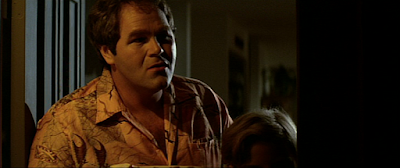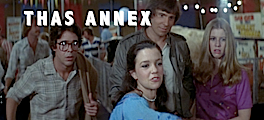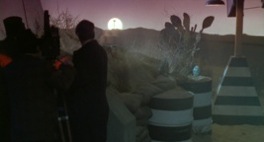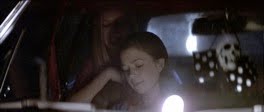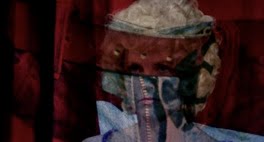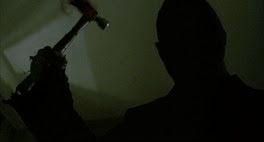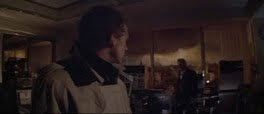Spielberg does not quite exhibit the analytical frames to have directed
Poltergeist. Spielberg inherits his own quaint settlement of rich mood-creation and storytelling as his
raison d'etre, while Hooper creates
analytical frames.
Cold, distanced images overtake any yearning for earthy, enriched tones; when enriched hues do occur here in Poltergeist, they are sustained frames overthrowing the hegemony of brazen fabulizing, holding no direct ideological motivation (that is, "this means this" or "that means that," or "this lends itself to that purpose" spoken in regards to an image, meaning the unequivocal nature of ideological images); neutralized is sublime, symphonic mood created through primarily emotion-based influence, and overturned is our traditional desire to be swept up by the momentary image of the creator's aesthetic whims, replaced by the demand for analysis asked of by unified images and an observation-based creation of symphonic cinema.
In other words, in Poltergeist, storytelling and mood take a backseat while something else comes to the fore. Hooper has something in mind, with Poltergeist, closer to documentation.
Take this image, for example, which observes its characters like a fly-on-the-wall, one that gently takes flight and hovers, without a dart or a bob, along the good path of observance, the most movement-stabilized fly (or even mechanical drone, which by now the cinema world should have realized is not the future of cinema) that has ever existed.
"Okay, okay. Just stand right here, okay?"
"Now listen... listen, I've kept Dana and Robbie out of this. But Carol Anne was here, so she knows, alright?"
"But Dana would blab..."
"... and Robbie would be up for three weeks."
STEVEN: "No, I think you should sit down, darling."
DIANE: "No-no-no, no-no-no!"
DIANE: "Now just stand, okay?"
DIANE: "Now just be calm."
STEVEN (quietly): "Okay."
DIANE: "Now reach back into our past, when you used to have an open mind. Remember that?"
STEVEN: "Uh huh."
DIANE: "Now just try to use that for the next couple of minutes..."
Now the analytical frame holds a certain number of prerequisites... one of which is the notion of "standard coverage" holding no influence over proceedings. A filmmaker can go crazy with bold compositions, denying the employment of standard coverage in that way, but the real sign of analysis is when a scene's shot design is sheared down to its bare essentials, shaved down to its sharpest point. Diane's new liberation - through the supernatural - is propounded by one of Hooper's trademark frames of uncanny entreaty (Diane reminding Steven of his "open mind" while his back is against the wall), always present when a Hooper dialectic is being made.
I'll also point out the milder tone Diane takes here, in contrast with the more judgmental tone she takes toward Steven in the script.
One aspect of Hooper's films, pointing toward a sort of auteurist sensibility (often perceived as a blander one), is Hooper's aversion to abrasive personalities when it comes to characterizing his protagonists, his primary audience surrogates. They always tend to be mild personalities, Platonic figures, not Type-A personalities with discernible quirks. Spielberg always tends to overcompensate when it comes to his female characters. His wives and mothers and heroines are always quite "tokenized" with traits, betraying a sort of lack of imagination with them. We can say this of all his characters, male or female. Hooper's characters, including his female ones, are as idealized in philosophical, Platonic terms as Spielberg's are idealized in movie-world terms. Histrionics, in a Hooper film, are saved purely for the moments of characters' confrontations with the fantastic and obscene.
CAROL ANNE: "Mother didn't cook any dinner."
DIANE: "We'll go to Pizza Hut, okay?"
DIANE: "Okay, now. Now, just look."
The analytical frame makes a point of our relationship to objects, supposing a divide in the realms between humans and objects. It is not just a simple separation, of semiotics and object shots, where objects are cut to in insert shots, but a direct analysis of our coexistence with them. If they exist in themselves, even move and affect the physical world in themselves, then it is important not simply to give moments of prominence to them, but to analyze how humans cannot usually perceive their power totally separate from themselves. Thus, a chest-and-up two-shot of Diane and Steven excludes the chair, that which she perceives to carry influence over, and the chair is revealed in a wide that cuts the humans' heads off.
The greatness of
Poltergeist is that its most uncanny moments require no great special effects. The scenes of greatest cinematic prowess are not the process shots, or the mechanical prop shots, but the supernatural caught in analytical frames, which are necessarily not the shots fussed and fretted over by effects men and compositors with minute specifications.
"Just look. Just watch."
I don't know. Spielberg has his moments of inspired angular shots, but this seems a particularly Hooperian, off-kilter shot, no? It's not too crazy, just ever so slightly imbalanced, which is Hooper's forte.
A two-step shot pairing to depict the chair's journey: a first shot that tilts upward as the chair careens closer to it... then a booming-down shot that moves to the rear of the previous shot. It is stylish, but what makes it particularly seem align with Hooper's sense of style is its daring awkwardness as a clear linear construction, an algebraic shot(x) = shot(y), a binary pairing of a 1 and a 0.
(DIANE cheers.)
Doesn't mean anything, but still interesting to note, that the chair goes in the opposite direction than what was eventually filmed. The filmed version of events is much preferable: rather than having the chair go towards Steven like some sort of provocation, it moves away from the couple together, an act completely separate and independent from the humans witnessing it.
STEVEN: "Hmm."




DIANE: "Come here, sweetheart."
DIANE: "Honey, can you move the chair out of the way, and just stay down there."
DIANE: "Come on, baby, let's show daddy."
CAROL ANNE: "I'm hungry!"
DIANE: "Now don't argue with Mommy, come on!"
DIANE: "Come on, let's just do this once."
DIANE: "All right, here we go."
The camera pulls back as an arch, maniacal emphasis on Diane's comic indelicacy forcing Carol Anne into one more go as guinea pig.
CAROL ANNE: "I want pepperoni pizza."
CAROL ANNE: "Mommy, that burned."
DIANE: "Oh, sweetie, I'm sorry, the floor needs more wax! Steven, come on, you do it."
STEVEN: "No."
DIANE: "Oh, come on, honey, try!"
STEVEN: "Uh uh."
DIANE: "It's like-- it's like, there's this tickling, you know? Right in here? And it-- and it starts to pull you. The tickling pulls you. And all of a sudden it's like there's no air."
"... Except that you can breathe!"
"And you're getting pulled along, and..."
What happens at this point in the script is really interesting. Firstly, the edit between the kitchen and outside the Tuthill's door has been a point of much contention for Poltergeist fans, who don't know how to comprehend such a "messy" edit, or a scene that seems to cut off before all the relevant information seems to be given. I find it works perfectly well in a conventional sense, the cut of course underscoring Steven's tunnel vision and incomprehension, and as a comic elision to Diane's enthusiastic ramblings - it's been done. But, in the script, the scene goes in a completely different direction: Steven is conversant and goes on to say the funny and sympathetic line, "I hate Pizza Hut! Where's supper? I don't understand, Diane. What the hell's going on here?" As a depiction of patriarchal befuddlement, it's quite amusing. The couple then go on to discuss what to do next, and a whole bit of dangerous humor is introduced when Carol Anne sits on the supernatural hotspot once again to show off and is careened towards the wall with no one to catch her, cracking the wall with her helmet before getting up, "dazed but unhurt."
There is the speculation that the scene was shot and cut out because of litigiousness on behalf of Pizza Hut. There's also the chance they didn't shoot it. I quite like the dialogue that occurs, but I would personally speculate that Hooper didn't feel quite attune to the banal observant humor of the omitted scene and chose the option more to his sensibility: to have Steven play overly sensitive to the uncanny effect, and fall into a stupor. I probably would have admired him more, though, if he had gone through and filmed Spielberg's banal and playful dialogue. As for the introducing of danger into the scene with Carol Anne's collision, I am glad they opted out of that - it would introduce too much (of what is to come) too soon.
DIANE and STEVEN: (In the middle of an argument) (indecipherable.)
(Tuthill emerges.)
STEVEN: "Hi, Ben."
DIANE: "Oh, Mr. Tuthill. Hi."
TUTHILL: "Look, my TV's not on, so if you have a problem with your set again..."
DIANE: "Oh, no..."
STEVEN: "No no no no, Ben, it's nothing like that."
STEVEN: "Diane and I were just wondering, uh... this is gonna sound strange, coming from me.
TUTHILL: "Doubt that!"
I like to see this scene (and the last) as the return of the stoner
Steven and Diane that we came to know and love. Steven reverts to a
primitive stupor in the face of phenomenon beyond our comprehension, and
then there's this scene in which the two act like boneheads.
(DIANE and STEVEN laugh politely.)
STEVEN: (lightly) "Those mosquitos... they're something awful..."
 DIANE: (laughing) "Yeah! They're chowing down..."
DIANE: (laughing) "Yeah! They're chowing down..."
TUTHILL: "I've never been bothered by them. Fact is I don't ever think I've been bitten by one them."
"Far as I know, nobody in my family's ever been affected by them. A mosquito ever suck on you, son?"
SON: "I don't know, Dad."
TUTHILL: (To Freelings) "He don't know."
A nice bit of Spielbergian social acerbity, unextraordinariness being equated with the best luck.
DIANE: (suppressing embarassed laughter) "Uh... Look, Mr. Tuthill."
STEVEN: "Ben."
DIANE and STEVEN: (hysterical laughter)
DIANE: "Ben."
STEVEN (sobering up, very quickly): "We're really sorry."
STEVEN: "Boy, I feel like a fool."
DIANE: "I'm sorry, but I had to say something. You were losing a pint of blood every few seconds."
STEVEN: "Well, we're gonna keep this thing in the family, Diane."
DIANE: "Don't scratch."
STEVEN: "In the morning, I'm gonna call somebody in."
DIANE: "Oh yeah? Who, for instance? I already looked in the Yellow Pages. Furniture movers, we got. Strange phenomenon? There's no listing."
One of the clunkier lines in the film...
ROBBIE: "One one-thousand, two one-thousand, three one-thousand, four one-thousand, five one-thousand..." (Thunder cracks.)
DIANE: "Honey, look! Look, I'm the one who has had to live with this freaky thing all day and nothing bad happened."
"It's like another side of nature, you know, a side of nature you and I are not qualified to understand!"
"When you overreact like this it makes what happened much too important."
STEVEN: "No one's going in the kitchen until I know what's happening."
(A second pot joke in Spielberg's script.)
ROBBIE: "One one-thousand, two one-thousand..."
"... three one-thousand, four one-thousand..." (Thunder cracks.)
ROBBIE: "One one-thousand, two one-thousand..."
"... three one---..." (Thunder cracks.)
ROBBIE: (Faster) "One one-thousand, two one-thousand...!"


I love these overtly "object" frontal shots, especially when there's movement, especially when there's a configuration of bodies, especially when characters end up too close to the camera than seems appropriate. Hooper's done a number of these.
A wonderfully wide-angle, almost "fish-eye," certainly "fish tank," shot. It looks like Steven and Diane are caught in an aquarium.
A great camera move - a frenetic dolly-back movement - from the door as Steven is seen behind it, a sprinting shape behind a cascade of rain.
Sentient branches block their way through the door.

A nice pan movement is used to dynamize the scene. (There's actually a functionally similar and better one in the film's climax.)
"MO-
"-MYYY!"
A rather hyperactive cut is used in this last moment that is not to my liking, but c'est la vie.




















































































































